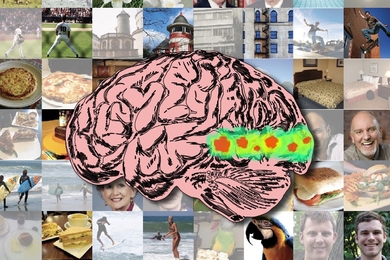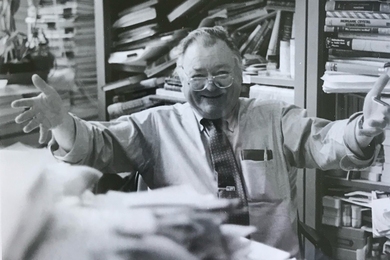With his latest publication, Professor William Mitchell has changed the whole experience of reading a book. His City of Bits: Space, Place and the Infobahn is believed to be the first book simultaneously printed on paper and published on the World Wide Web, complete with links and interactive functions that no traditional volume could ever have.
City of Bits (MIT Press and ) provides an overview of a new type of city composed of invisible links and virtual sites on the information superhighway rather than physical buildings, roads and cities. Chapters address such phenomena as "Electronic Agoras" (an agora is an ancient Greek assembly place), "Soft Cities" and "Cyborg Citizens." Dr. Mitchell is professor of architecture and media arts and sciences and dean of the School of Architecture and Planning.
The on-line version of City of Bits, which became available in June, offers much more information than the printed book by virtue of the Web's almost limitless interconnections. For example, at the beginning of the "Electronic Agoras" chapter, Professor Mitchell discusses his morning routine of checking his e-mail, the weather and on-line news while drinking his coffee. The reader can click on the word "coffee" and be transported to a Web site providing links to dozens of other coffee-related pages including Internet news groups, an FDA report on coffee and various cities' cafe guides. In another sentence comparing the early telecommunciations networks to the tangled layout of Paris, clicking on the city's name retrieves a map of Paris from a Web server at the University of Texas.
When Professor Mitchell began writing the manuscript, the Web existed, but today's popular browsers like Netscape were not yet widely available. However, by last spring when it was about to go to press, he realized that it would be "awfully embarrassing" to publish a book about the rapidly increasing importance of the Internet without an electronic adjunct. "It was about time to do an experiment of this kind," he said. "The Web changes quickly and we wanted to be the first," added Daniel Stevenson, a junior in physics who helped put City of Bits on the Web as a UROP project.
The project was accomplished relatively quickly with the help of an MIT Press team including project manager and "webmistress" Theresa Ehling, graphic designer Jeffrey Kalin, and Anne Beamish, who located many of the Web sites to which City of Bits would be linked. Starting in April, Mr. Stevenson wrote software to convert the book's text files to a Web-compatible form, then designed accompanying interactive tools including a search facility, a comment utility whereby readers can respond to the author or to each other (and which saves and organizes comments by subject), and a listing of other interesting Web sites suggested by readers. Links between the text and footnotes are also provided, so readers can easily go back and forth without flipping pages back and forth as books usually require.
Since there was no precedent for a book being printed and electronically published at the same time, the question of market effects arose when the project was in the planning stages. Would the availability of the book on the Web hurt print sales, since access is free, or would it act as an advertising vehicle and increase orders for the paper version? It's difficult to tell for sure, Professor Mitchell said, although he noted that the first press run of 5,000 copies sold out unusually quickly. "I'd bet we made more sales than we lost," he said.
Ms. Ehling was more certain about the electronic edition's beneficial effects. "It has definitely helped" hardcover book sales, she said. A statistics utility created by Mr. Stevenson revealed that for the first three weeks of August, the on-line book got more than 35,000 visits from Web readers, averaging 1,755 "hits" per day. About 75 copies of the book have been ordered directly through the Web, Ms. Ehling added.
Many readers partake of both versions. "The printed and on-line books really play different and complementary roles," Professor Mitchell said. The paper version is portable "and encourages a style of reading that's very focused. No one wants to read an entire book off the screen." In contrast, the electronic counterpart, by virtue of the interactive capabilities and hyperlinks, encourages reading small sections at a time and skipping around to related material on other Web sites at the whim of each individual reader.
Because the Web is constantly changing and growing, the book will change with it. Some of the sites to which it is linked will become inactive or altered as time goes by, "which results in a very important authorial responsibility," Professor Mitchell said. "The site is a lot more than the text that appears in the book. We have to keep going through and pruning out the dead links, and I'll probably add 20 or 30 links tonight." A "caveat surfer" disclaimer on a City of Bits Web page that lists other sites by subject warns readers of the varying quality of those sites and eventual "link rot." "It's very dynamic and open-ended, and that's very threatening to many authors," he noted.
As far as electronic reader reaction goes, "I've been impressed with the thoughtfulness of the comments," Professor Mitchell said. "I've had more interesting dialogue on this book than any other I've written."
City of Bits is the first of its kind but hardly the last. Professor Mitchell is planning to do another print/on-line book, but this time he will write it as hypertext from the start-"tricky but doable," he said. As the Web evolves, he hopes to have a more sophisticated linking device whereby a reader can get a glimpse of what lies on the other side of a link before actually going there, like being able to peer through a window in a door. Other types of books such as textbooks, which by nature are neatly divided into sections and subsections, lend themselves well to Web publication, Mr. Stevenson noted.
MIT Press expects to publish similar works by other authors, but they won't closely resemble City of Bits; they'll take different forms as the Web evolves. "We don't want to treat this as a template," Ms. Ehling said.
A version of this article appeared in MIT Tech Talk on August 30, 1995.





